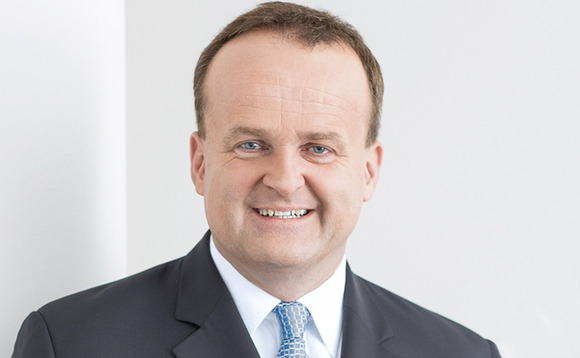
GP Profile: Deutsche Beteiligungs AG

- Closed €1bn DBAG Fund VII in September 2016 (20% invested)
- 44 buyouts in firm's history (29 exited)
- Most active DACH mid-market investor over past three years (15 deals)
- 75% of exits to trade buyers
- Capital multiple of around 5x on Formel D and Proxes
Deutsche Beteiligungs AG has deployed around 20% of its latest fund and made numerous exits in 2017 so far. CEO Torsten Grede talks to Oscar Geen about the firm's place in the development of the German LBO market and the firm's recent activity
When Torsten Grede joined Deutsche Beteiligungs AG (DBAG) in 1990 there was no such thing as a DACH mid-market buyout firm. Even if there had been, he might not have joined one: "I wanted to go into early-stage intervention capital but I settled for later stage private equity." But he explains that the influence of the anglo-saxon capital markets on the buyout model in the 90s made things more interesting and kept him around: "We did 10 buyouts between 1996-2000 and this enabled us to raise our first LP fund in 2002. This development kept me in the industry and in the company."
The first LP fund, DBAG Fund IV, was a €228m vehicle that completed 11 investments in total and performed well enough that most of the investors came back for Fund V. The GP easily surpassed the target of €375m for the successor, holding a final close on €434m in November 2005. After the financial crisis, Grede finally got his wish to be involved in early-stage intervention capital as DBAG raised a €242m expansion capital fund. This fell short of its target of €250m but was considered a "big success" at the time, says Grede, due to the difficult fundraising environment.
The next buyout fund was the largest ever raised by a German private equity company. DBAG VI closed on its hard-cap of €700m in April 2012 and is now more than 90% invested, with the remaining dry powder being retained for add-ons. However, deploying this much capital is never easy, and the prospect of a 25% increase for the next fund was daunting. Grede explains that a top-up fund structure helped ease the pressure to deploy for their most recent and largest fund to date. The €1bn vehicle, which closed in July 2016, is structured as an €800m main fund with an extra €200m top-up fund available for larger transactions. This allows the fund to underwrite equity tickets of up to €200m without the same deployment pressures associated with a straight €1bn fund because the management fee is only charged on deployed capital for the top-up vehicle.
One of the main issues we've previously had with being competitive for larger tickets in auctions is having to consult with so many co-investment committees" – Torsten Grede, Deutsche Beteiligungs AG
Not only does this give the manager flexibility to pursue larger tickets with less pressure on deployment, Grede says it also eases the auction process. Previously, the GP relied on LPs making co-investments to boost the size of the equity investment. "One of the main issues we've previously had with being competitive for larger tickets in auctions is having to consult with so many co-investment committees," he explains. Being able to top the equity ticket up themselves makes this process simpler.
Nonetheless, DBAG avoids the larger auctions where possible. "We have a very good network in Germany, which gives us access to good, family-owned Mittelstand companies. This helps us to find situations where the competitive situation is not full-blown," says Grede. He describes the success rate in auctions as fair, explaining that the GP looks at around 200 investments per year, conducts further analysis on around 50 and then makes indicative offers on roughly 20. In the past three years DBAG has been the most active mid-market investor in the DACH region, according to unquote" data, completing 15 buyout transactions between June 2014 and June 2017.

Racking up exits
To date, 2017 has been a good year for exits as well. So far, DBAG has made four exits from Fund V and one from Fund VI. These divestments give an average capital multiple of 3.94x, above the company's average of 2.6x due largely to the 5.5x recorded on both the sales of Formel D to 3i and Proxes to Capvis Equity Partners. Because DBAG also co-invests from its balance sheet in all of its buyouts, this has meant a €47.7m contribution to the company in the first half of the 2016/17 financial year.
Unusually for DBAG, four of these have been secondary buyouts whereas 75% of all of the GP's exits are trade sales. "This is not typical in the market but it's typical for us. We invest in interesting business models and focus on B2B businesses. These are very attractive for strategic acquirers," says Grede, adding that in the last 10 years this has not changed very much. "For the last decade we've been talking about Europe, the US and Japan, now we would also include China." This was highlighted in the sale of Romaco to China-based engineering firm Truking group in May 2017. This was another successful exit, generating a multiple of 2.4x and contributing €6m to DBAG's balance sheet.

Results in and above this range in the past five years have kept DBAG's average capital multiple high at 2.6x and led to what Grede describes as a "very good demand situation" when it comes to fundraising. A high proportion of LPs have reinvested in the new fund making up 80% of commitments. Geographically, the largest group is from neighbouring European countries and the UK, the second largest group is from the US, the third largest is German investors and a few Asian LPs make up the difference. By investor type, this is split with 38% of commitments coming from pension funds, 17% from funds-of-funds, 10% from insurance companies, 10% from banks and 10% from elsewhere.
DBAG expects to be fundraising again in the next two years but has some dry powder to deploy first. At the time of writing, DBAG Fund VII was already around 20% deployed after completing three buyouts in the first half of 2017 and has a strong pipeline lined up for the second half.
Key People
• Torsten Grede, CEO, joined DBAG in 1990 and has been a member of the board of management since 2001. Responsible for strategy and business development, investment business, fund investor relations, corporate communications, compliance and ESG.
• Rolf Scheffels, member of the board, joined DBAG in 1997 and has been a member of the board since January 2004. He began his career with the audit firm C&L Deutsche Revision in 1992 before earning his doctorate in 1996. Responsibilities include investment business and investment team development.
• Susanne Zeidler, CFO, Joined DBAG in 2012 after 25 years in corporate finance and auditing. She began her career in 1987 and moved to KPMG in 1990. Zeidler is a board member of LPEQ. Her responsibilities include finance and accounting, stock market investor relations, investment controlling, legal and tax, risk management, internal audit, HR, IT and general organisation.
Latest News
Stonehage Fleming raises USD 130m for largest fund to date, eyes 2024 programme
Multi-family office has seen strong appetite, with investor base growing since 2016 to more than 90 family offices, Meiping Yap told Unquote
Permira to take Ergomed private for GBP 703m
Sponsor deploys Permira VIII to ride new wave of take-privates; Blackstone commits GBP 200m in financing for UK-based CRO
Partners Group to release IMs for Civica sale in mid-September
Sponsor acquired the public software group in July 2017 via the same-year vintage Partners Group Global Value 2017
Change of mind: Sponsors take to de-listing their own assets
EQT and Cinven seen as bellweather for funds to reassess options for listed assets trading underwater








